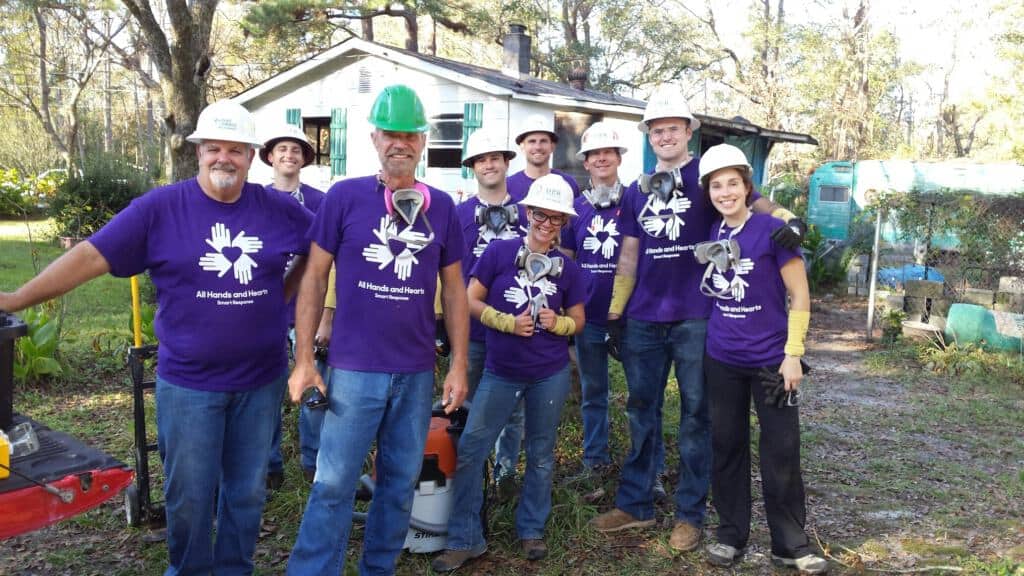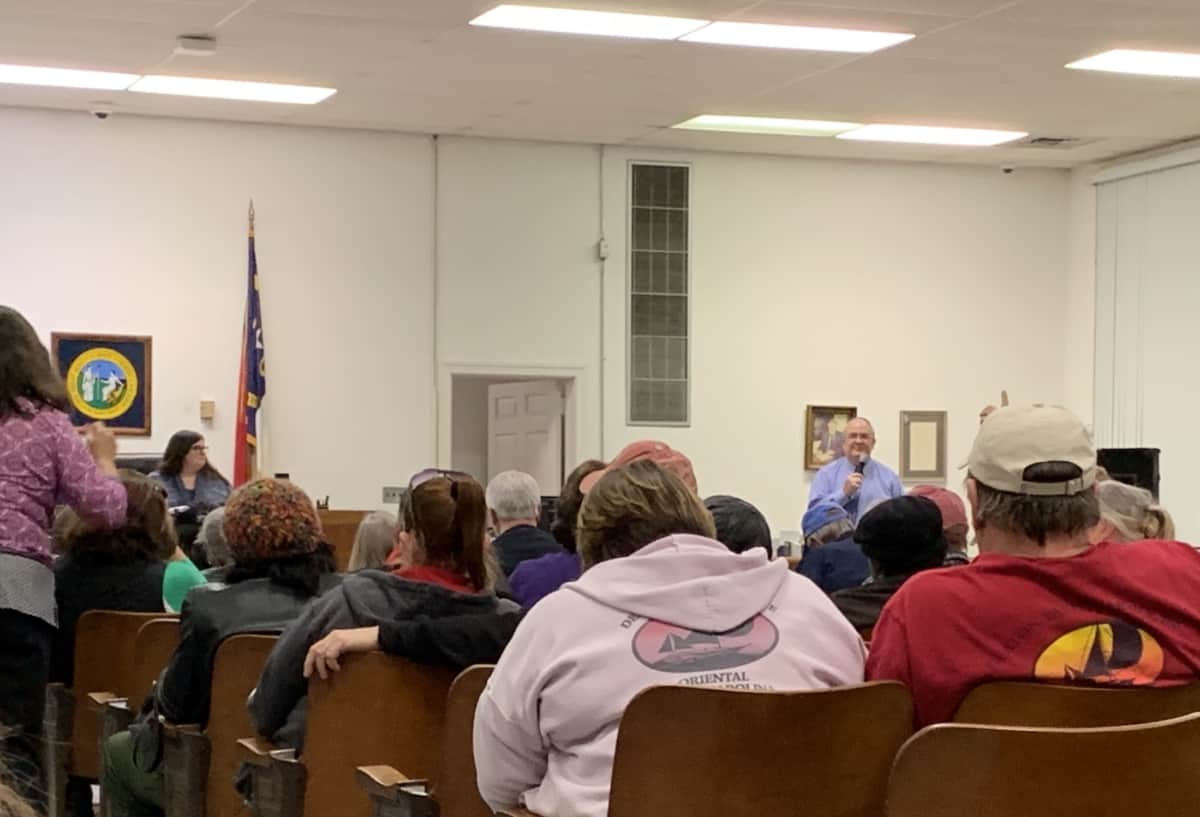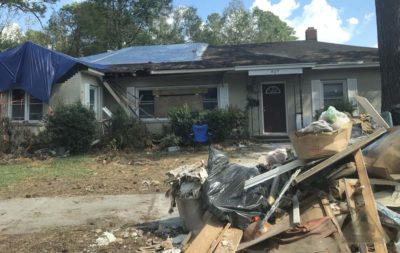The swarming and swirling rains and winds of Hurricane Florence have long-since subsided. Now, survivors are left in a dizzying spin of numbers and acronyms — of FEMAs and SBAs, HMGPs and STEPs, and 404s and 407s — wondering where and how to get help for long-term recovery after the storm.
One of the first places residents turn is to their local governments. But county officials are wearing many hats, having addressed issues related to debris, mosquito control, and initial damage control, while also organizing massive efforts to discover what the needs are in their communities.
“There’s so much to do, and that’s the challenge — having a centralized clearinghouse that people can go to and find out all the resources and things they can apply for,” Pamlico County Manager Tim Buck said. “We do struggle with that. Getting the information out is a challenge. Even us, we don’t know all of the resources out there.”
Local governments and volunteers led immediate efforts
In the immediate wake of the storm, survivors returned to their homes and an overwhelming sense of loss. News reports of state and federal monetary allocations were heartening, but felt far away — and certainly not as urgent as the need to get water and water-contaminated items out of their homes.
“For me, FEMA hasn’t been what’s helped me the most,” Christy Strickland said. “It’s been a lot of volunteers.”
It was people from within the community — from schools, churches, and volunteer organizations — those who descended from inside and outside the state, neighbors, and local counties.
For Strickland, she was put in contact with All Hands and Hearts, a disaster-response non-profit that had set up camp in nearby New Bern. All Hands and Hearts organizes volunteers and deploys resources to respond in the immediate aftermath of a disaster, and then “stay until the job is done,” according to their website.

“They are the ones that are here,” Strickland said. “They’ve been here since it came, and they helped my mom muck-and-gut. They also just helped with the mold and mitigation. And we’re trying to get on a rebuild list because she got very minimal help with FEMA and it’s been a hard process to try to appeal.”
Volunteers gutted the interior of her mother’s house as well as hers. They carried items to the curb and helped load cars.
“Something that would take you months to do, they come out and did it in three days,” Strickland said.
And they weren’t alone. Similar organizations, as well as droves of volunteers from within the community, schools, and local churches were on the ground. Schools set up make-shift stores for residents to gather needed supplies, while churches fed and housed thousands.
“I posted on Facebook and said, ‘I need help,’” Jennie Kennel Adams said. “And my church sent about 16 folks over. I’m a gymnastics judge, and my gymnastics community sent about 10 people over. So I had about 20 people in the house the next day, taking everything out.”
The confusion over what had happened was there, but there was no confusion as to where the help was coming from.
“At that time — it’s what we needed,” Strickland said. “The community definitely came out and supported each other.”
Added Adams, “It’s a long process, but I think the community sticking together and pulling together has made it at least — you know, you feel the love and support from everybody.”
But the immediacy of the event has passed and what settles in is the enormity of the task ahead. For those displaced from their homes, they need repairs. In some cases, they need to elevate their entire property. In others, either their homes or the apartment buildings they lived in have been condemned, and they don’t know where to go.
“Now, it’s more or less long-term recovery stuff, and that’s just a slow, hard go,” Buck said. “We hope we can get everybody identified and fixed.”
In addition to more volunteers for home rebuilds and housing construction supplies, the most pressing need seems to be identifying those impacted and getting them on the radar for state and federal programs.
State and federal funding support on the way
With damage estimates at $17 billion, and about a third of that attributed to home owners, housing relief is a major concern. The state estimates private insurance will cover $4.8 billion in storm losses, the federal government has pledged $2.5 billion in aid, and Governor Cooper has proposed about $800 million in state support. But it leaves questions for impacted residents — the primary one being: how do they get the money?
Many can start with flood insurance, but that’s not an option available to all. In fact, something like 70 percent of the homes impacted were either uninsured or underinsured.
“My mom didn’t carry flood insurance because it never flooded and she wasn’t in what was considered a flood zone at the time,” Strickland said. “When [Hurricane] Irene came, we inquired into it and they didn’t see it as necessary, I guess.”
But her mother’s home took in half-a-foot of water, and her own home took in almost three feet of water. Strickland is living with her entire family, including her husband and two kids, with her mother’s boyfriend while she tries to figure out the path forward for herself and for her mom.
“My mom is 74. It’s the home she built with my father who’s passed away that I’ve now gutted completely,” Strickland said. “It has gutted all of her memories that her and my father built, because they built it. And now she has, I would say, post-traumatic stress, and I’m trying to get her in any type of program I can that will potentially assist her.”
The first place the state advised residents to go was to FEMA and the Small Business Administration (SBA). Each county hosts federal and state emergency management officials to collect information on losses and try to match survivors with benefit programs — ranging from financial assistance to direct housing assistance with FEMA and homeowners, business, and economic injury loan programs with the SBA.
“But it’s hard to determine what you qualify for and what you don’t,” said Jean Jerger, who is mostly done repairing her home but still searching for ways to get the rest done. “And if you don’t qualify, where do you go?”
Many residents felt registering with FEMA or the SBA was a waste of time, because from stories they heard or firsthand experiences, they did not think they would be approved for relief. But in not getting rejected for some programs, residents remain ineligible for others.
“It’s a little bit confusing because folks don’t realize that some programs related to FEMA’s other need grants — which are pure grants, not loans — you have to be turned down for an SBA loan before you become eligible,” said Beth Schrader, chief strategy officer for New Hanover County. “So, it’s sort of this Byzantine maze of rules and regulations that we’re trying to very proactively share with folks to say, ‘Here’s the process.’”
Strickland and Adams experienced a bit of this, when after being rejected for certain FEMA programs, they later found a $600 check from the American Red Cross in their mailbox.
“I think the state person at the FEMA office did something to get me on a list,” Strickland said. “So it’s good I went there.”
It’s a relevant lesson for today, where some registration deadlines have passed but county officials urge residents to still come forward, identify themselves and seek help for other programs, such as FEMA hazard mitigation programs, that are still available.
“We have to know who you are and that you need help,” Buck said.
Making yourself known
Knowing who needs the help has become vital. Buck recounted a lesson on this recently. Initially, FEMA turned down Pamlico County’s request for temporary housing because the numbers weren’t there to support the program. County officials knew there was a need, they just didn’t have the hard data to offer. So they banded together, organized volunteers and hit the ground — going door-to-door. The process is ongoing in order to bolster support for other programs, but it already worked in getting temporary housing.
In larger counties, the data was instrumental not only in seeking funding for federal and state programs but in addressing immediate concerns.
“We have a wealth of data that we were able to use and leverage in order to try and seek funding, to look at where you prioritize funding,” Schrader said. “We are using data analytics and visualization in a way that may not have been able to be used in prior storms. We were even able, on the ground in the midst of the storm, based on our preliminary damage assessment, to hot spot into individual neighborhoods and direct the disaster survivor assistance teams that were the first groups on the ground from FEMA, to tell them exactly where to go, block-by-block, based on the data we were seeing. And that is unprecedented.”
Smaller counties were not as fortunate to have this data on hand. For them, one of the biggest needs is volunteers to help in the effort to identify the unmet needs.
“We need volunteers,” Buck said. “We need people to help us do the assessments, the door-to-door, boots-on-the-ground kind of stuff. We’re doing the best we can right now but we can’t be everywhere.”
With help, survivors throughout the impacted areas — in the far reaches and across socio-economic lines — will have a better chance at recovery dollars, officials say.
“There’s a lot of data,” Schrader said, “and data’s what we’re going to be able to leverage to look at these outcomes and data’s what we’re going to be able to leverage to get additional funding and data’s what’s going to show what’s working and not.”
Added Schrader, “The other piece to this is about being creative and layering different funding sources to try and achieve these outcomes. So part of this is also about having a very outcome-focused recovery process, to say, ‘What is it that you want to accomplish?’ and then opportunistically looking at the funding opportunities to layer knowing this is really what we’re trying to accomplish in the end. It’s about taking a more proactive, longer-term view versus just being reactionary.”



